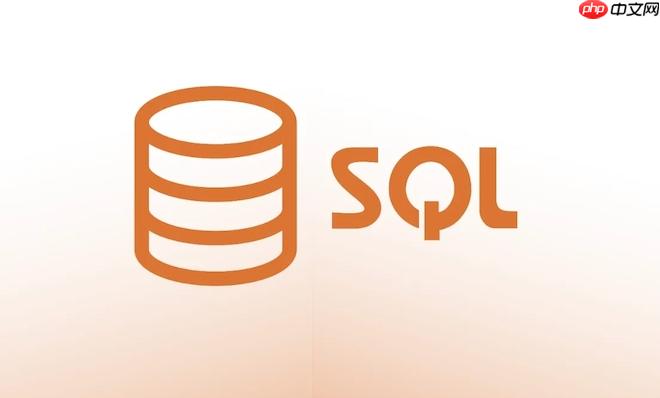识别并优化慢查询需从日志入手,利用慢查询日志和监控工具定位问题sql,再通过EXPLaiN分析执行计划,查看是否全表扫描、使用临时表或文件排序;常见性能陷阱包括select *、WHERE中对索引列使用函数、JOIN无索引、模糊查询前缀含%、ORDER BY/GROUP BY无索引等,应针对性优化;索引是关键加速手段,需遵循最左匹配原则,善用覆盖索引,避免冗余;同时调整数据库配置如innodb_buffer_pool_size、tmp_table_size等参数,平衡读写性能,实现系统级优化。

处理SQL查询中的慢查询,核心在于系统性地识别、分析并优化。这通常意味着我们需要深入挖掘数据库的性能日志,理解查询的执行计划,并针对性地调整sql语句、数据库索引,乃至底层的配置参数,以实现更高效的数据访问。这并非一蹴而就,而是一个持续的诊断与迭代过程。
解决慢查询问题,在我看来,就像医生诊断病情。你不能只看症状(查询慢),得找到病根。这通常涉及几个关键步骤:
我们首先要做的,就是识别那些“病态”的查询。这通常通过数据库的慢查询日志来实现,它会记录下所有执行时间超过预设阈值的SQL语句。有些时候,我们也会借助一些专业的APM(应用性能管理)工具或数据库自带的性能监控平台,它们能更直观地展现哪些查询在特定时间段内耗时最多、资源占用最大。识别出来后,我们便能得到一份“嫌疑犯”名单。
接下来,就是深入分析这些“嫌疑犯”的作案手法。对于每条慢查询,我个人习惯使用数据库的
EXPLAIN
(或
EXPLAIN ANALYZE
在postgresql中)命令,这简直是数据库优化师的“X光机”。通过它,我们可以清晰地看到查询是如何被数据库执行的:它是否使用了索引?扫描了多少行数据?是否进行了全表扫描?是否需要创建临时表或进行文件排序?这些信息能帮助我们快速定位到性能瓶颈所在。例如,如果
EXPLAIN
结果显示
type
是
ALL
(全表扫描)或者
Extra
中出现
using filesort
、
Using temporary
,那往往就是问题的症结。
优化语句是解决慢查询最直接的手段。这包括但不限于:
- *避免`SELECT `**:只选取你真正需要的列,减少网络传输和内存开销。
- 优化
WHERE
子句
:确保条件能有效利用索引,避免在索引列上使用函数或进行类型转换,这会导致索引失效。 - 合理使用
:优先选择内连接,避免不必要的笛卡尔积,确保连接条件有索引。
JOIN
- 减少子查询:在某些情况下,子查询可以被
JOIN
或
EXISTS
替代,从而提高效率。
- 分页优化:对于大偏移量的
LIMIT OFFSET
,可以考虑使用基于游标或上次查询结果的ID范围进行分页,而不是直接跳过大量数据。
- 批量操作:对于大量数据的插入、更新或删除,使用批量操作而非逐条处理,能显著减少数据库交互次数。
最后,但同样重要的,是索引的创建与调整。合适的索引能让数据库快速定位到所需数据,避免全表扫描。但索引并非越多越好,它会增加写入操作的开销,并占用存储空间。所以,我们需要权衡。同时,数据库的配置参数也需要根据实际负载进行调优,比如调整
innodb_buffer_pool_size
(mysql)来缓存更多数据和索引,或者调整
work_mem
(PostgreSQL)来优化排序和哈希操作的内存使用。这些底层的配置,往往能在整体上提升数据库的运行效率。
如何有效地识别并定位SQL慢查询的根源?
识别和定位SQL慢查询的根源,我觉得这就像侦探破案,需要证据和线索。我们不能凭空猜测,得有实实在在的数据支撑。
最直接的证据,莫过于数据库的慢查询日志(Slow Query Log)。在MySQL中,你可以通过配置
slow_query_log = 1
和
long_query_time = 1
(表示查询时间超过1秒的都会被记录)来开启它。甚至,你还可以设置
log_queries_not_using_indexes
来记录那些没有使用索引的查询。这份日志文件会详细记录下执行时间超标的SQL语句、执行时长、锁定时长、发送给客户端的行数等等。我个人经常会用
pt-query-digest
这样的工具去分析这份日志,它能把海量的日志数据聚合、排序,快速找出最慢、最频繁的查询,效率极高。
除了日志,实时性能监控工具也是不可或缺的。云服务商(如AWS RDS Performance Insights、azure SQL database Intelligent Insights)提供的监控面板,或者自建的prometheus + grafana组合,亦或是Percona Monitoring and Management (PMM)这类专业工具,它们能以图表的形式展现数据库的CPU、内存、IO使用情况,以及活跃会话、慢查询数量等关键指标。通过这些工具,我们能直观地看到数据库在哪个时间段、哪个模块出现了性能瓶颈,甚至能直接定位到当时正在执行的慢查询。
而一旦我们锁定了某个“嫌疑”查询,下一步就是用
EXPLAIN
命令进行深度剖析。这是我每天都会用到的“透视镜”。在MySQL中,
EXPLAIN SELECT ...
会返回一张表,其中包含了查询执行的详细计划。我最关注的几个字段是:
-
: 这是访问类型,从好到坏依次是
type
、
eq_ref
、
ref
、
range
、
index
、
ALL
。看到
ALL
(全表扫描)通常就意味着大问题。
-
: 可能用到的索引。
possible_keys
-
: 实际用到的索引。如果
key
possible_keys
有值但
key
是
,那说明索引失效了。
-
: 预计需要扫描的行数。这个值越大,查询通常越慢。
rows
-
: 这个字段经常藏着“玄机”。例如,
Extra
Using filesort
表示需要对结果进行外部排序(通常是内存或磁盘),
Using temporary
表示需要创建临时表来处理查询(如
GROUP BY
或
DISTINCT
),这两者都是性能杀手。
Using index
则表示使用了覆盖索引,这是非常高效的。
通过这些线索,我们就能像剥洋葱一样,层层深入,最终找到慢查询的真正根源。
哪些常见的SQL语句编写模式会导致性能瓶颈,应如何规避?
在我的经验里,很多慢查询并非数据库本身的问题,而是我们写SQL语句时的“无心之失”。有些模式,初看起来没什么,但数据量一上去,性能瓶颈就暴露无遗了。
一个非常普遍的问题是*滥用`SELECT `。我们图方便,直接把所有列都取出来。但实际上,很多时候我们只需要其中几列。这不仅增加了网络传输的负担,也可能导致数据库读取更多不必要的数据块,甚至影响到覆盖索引的使用。规避方法很简单,只选择你需要的列**。如果一张表有几十个字段,而你只需要其中三五个,那么明确指定它们能带来意想不到的性能提升。
另一个大坑是在
WHERE
子句中对索引列进行函数操作或隐式类型转换。比如
WHERE date(create_time) = '2023-01-01'
。
create_time
列上明明有索引,但
DATE()
函数一用,数据库就傻眼了,它不知道如何利用索引来快速定位数据,只能进行全表扫描。正确的做法是将函数操作放到等号的右侧,或者使用范围查询,例如
WHERE create_time >= '2023-01-01 00:00:00' AND create_time < '2023-01-02 00:00:00'
。同理,如果数字类型的字段你用字符串去比较,也可能发生隐式转换导致索引失效。
不恰当的
JOIN
操作也是性能杀手。比如,如果
JOIN
条件没有索引,或者连接的字段类型不匹配,都会导致数据库进行大量的全表扫描或哈希连接。有时候,我们甚至会不小心写出
CROSS JOIN
,导致生成巨大的笛卡尔积。规避之道在于,确保
JOIN
的字段都有合适的索引,并且连接条件清晰明确。对于复杂的连接,可以考虑先筛选出小数据集,再进行连接。
ORDER BY
和
GROUP BY
操作在大数据集上也常常是性能瓶颈的元凶。如果排序或分组的字段没有索引,或者索引无法完全覆盖,数据库就不得不进行文件排序(
Using filesort
)或创建临时表(
Using temporary
),这都是非常耗费资源的操作。优化它们的方法是为排序或分组的字段创建复合索引,并且确保索引的顺序与
ORDER BY
的顺序一致,这样数据库就能直接利用索引的有序性,避免额外的排序开销。
此外,
LIKE %keyword
开头的模糊查询也是索引的“绝缘体”,因为B-Tree索引无法处理前缀不确定的查询。如果业务场景确实需要这样的模糊查询,可以考虑使用全文索引(Full-Text Index),或者在应用层面做一些预处理,比如使用elasticsearch等搜索引擎来处理复杂的文本搜索需求。
最后,过多的
OR
条件有时也会让优化器感到困惑。在某些情况下,如果
OR
连接的条件涉及不同的索引列,数据库可能无法有效地利用它们。一个常见的优化思路是将
OR
条件拆分成多个
SELECT
语句,然后用
union ALL
连接起来,让数据库能够分别利用每个条件的索引。
除了语句优化,数据库索引和配置参数在慢查询处理中扮演什么角色?
说实话,光优化SQL语句有时候还不够,就像给一辆老旧的汽车换了高性能的发动机,但如果底盘和轮胎跟不上,整体性能还是会受限。数据库的索引和配置参数,就是这辆车的底盘和轮胎,它们对慢查询的处理起着至关重要的作用。
索引,在我看来,是数据库性能的“加速器”。它能让数据库在海量数据中快速定位到所需的数据行,而无需遍历整个表。我们最常用的是B-Tree索引,它适用于等值查询、范围查询以及排序。理解复合索引的“最左匹配原则”非常关键:如果你有一个
idx_a_b_c (a, b, c)
的复合索引,那么
WHERE a = ?
、
WHERE a = ? AND b = ?
、
WHERE a = ? AND b = ? AND c = ?
都能有效利用这个索引,但
WHERE b = ?
就无法利用。选择合适的列创建索引,以及选择正确的索引顺序,是门艺术。
除了B-Tree,还有Hash索引(适用于等值查询,但不支持范围和排序)、全文索引(用于文本搜索)等。更高级一点的,是覆盖索引(Covering Index),当一个查询所需的所有列都包含在索引中时,数据库就无需再回表查询数据行,直接从索引中就能获取所有信息,这能极大提升查询性能。但索引并非万能药,它会占用存储空间,并且在数据写入(
INSERT
、
UPDATE
、
)时需要维护,增加写入开销。所以,我们需要在查询性能和写入性能之间找到一个平衡点。
另一方面,数据库的配置参数就像是这辆车的各种调校按钮,能直接影响数据库的运行效率。 在MySQL中,
innodb_buffer_pool_size
无疑是最核心的参数之一。它决定了InnoDB存储引擎用于缓存数据和索引的内存大小。如果这个值设置得太小,数据库就需要频繁地从磁盘读取数据,导致大量的IO操作,性能自然就上不去了。通常,我会建议将其设置为系统可用内存的50%到70%,具体要看服务器是否还有其他应用。
还有一些参数也值得关注:
-
tmp_table_size
和
:它们控制了内存临时表的大小。如果查询需要创建临时表(比如复杂的max_heap_table_size
GROUP BY
或
DISTINCT
),并且数据量超过这个限制,数据库就会把临时表放到磁盘上,性能会急剧下降。适当调大这两个值,能让更多临时操作在内存中完成。
-
:这个参数影响排序操作的缓冲区大小。如果排序的数据量不大,可以在内存中完成排序,避免
sort_buffer_size
Using filesort
。
- 查询缓存(Query Cache):虽然在MySQL 8.0中已被移除,但在早期版本中它曾是一个优化手段。但它在并发高、数据更新频繁的场景下反而可能成为瓶颈,因为它需要频繁失效和重建缓存。所以,了解其历史和局限性很重要。
-
:合理设置最大连接数,避免连接数过多耗尽服务器资源,或者连接数过少导致应用等待。
max_connections
总而言之,慢查询的处理是一个系统工程,它不仅仅是改几行SQL那么简单。它需要我们从应用层面的SQL语句,到数据库层面的索引设计,再到系统层面的配置参数,进行全方位的审视和优化。这是一个不断学习、实践和迭代的过程。


评论(已关闭)
评论已关闭